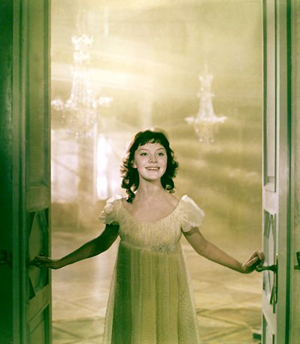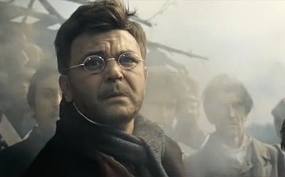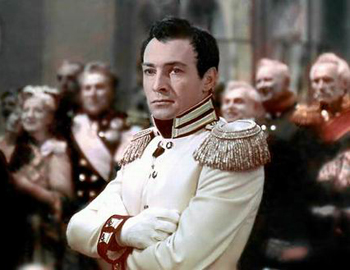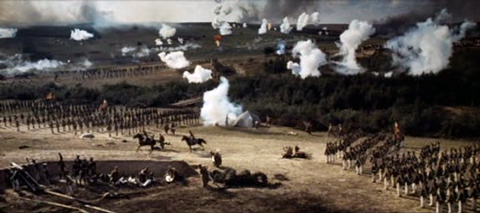| Release List | Reviews | Price Search | Shop | Newsletter | Forum | DVD Giveaways | Blu-Ray/ HD DVD | Advertise |
| Reviews & Columns |
|
Reviews DVD TV on DVD Blu-ray International DVDs Theatrical Reviews by Studio Video Games Features Collector Series DVDs Easter Egg Database Interviews DVD Talk TV DVD Talk Radio Feature Articles Columns Anime Talk DVD Savant HD Talk Horror DVDs Silent DVD
|
DVD Talk Forum |
|
|
| Resources |
|
DVD Price Search Customer Service #'s RCE Info Links |
|
Columns
|
 |
War and Peace
|
||||
A gargantuan version of Tolstoy's national epic, approached as a priority as important as the Soviet space program, War and Peace is surely the biggest production ever put on film, with entire armies filling the screen and covering vast landscapes. The recreation of the Napoleonic era in St. Petersburg and Moscow is marvelous to behold. Director Sergei Bondarchuk makes the story work even better at the intimate level. The romantic adventures and heartbreaks of the central trio, Pierre, Natasha and Andrei lead to at least four or five devastatingly emotional highpoints. Previously, there was the 1956 Dino DeLaurentiis version. Except for some awkward casting, it wasn't half bad, but it pales beside the opulence and scope of this colossus. Ruscico's version is both longer and better presented than previous releases, and Image has packaged it with helpful extras and easily-navigated menus. More on that below. 
Film 1: Andrei Bolkonsky, parts one and two (140 minutes): The sweeping story of Russian nobility during the Napoleonic wars starts in 1805. At the Moscow Rostovs, young Natasha (Lyudmila Savelyeva) is a child dreaming of romantic affairs. Frequent guest Pierre Bezukhov (Sergei Bondarchuk, the director) takes a serious liking to her. Russia allies with Austria against Napoleon, so before he leaves to fight Prince Andrei Bolkonsky (Vyacheslav Tikhonov) parks his pregnant wife in the country with his father and sister. For Natasha's brother Nikolai it is a first battle. Back in Moscow, Pierre is easily pressured into marriage with the beautiful but decadent Hélène, who is soon rumored to be taking lovers. Pierre challenges one of them to a duel, and has a crisis of conscience after wounding the man severely. Andrei returns to his country home just in time to see his wife die in childbirth. He determines that life is worthless. Then Spring comes and the world seems to be reborn.
Savant was excited to see this pricey-but-exceptional DVD release. Ruscico has a reputation for quality editions of hard-to-see Soviet pictures, and War and Peace is certainly the prize title, at least for Western audiences unfamiliar with the majority of Mosfilm's output. I saw the American release when sixteen years old, serialized over two weeks in a fancy theater in San Bernardino. I can't say I followed the story well, and mostly remember the grainy, washed out picture and the distracting English dubbing -- Natasha's voice squeaked like Minnie Mouse. But the eye-popping visuals stayed burned into my memory, especially a God's eye view, receding into the heavens, of the Austerlitz battlefield spread out below. It looked as if it took in miles of smoke and fighting. 
In Russian with subtitles in a number of languages, the new Ruscico / Image DVD is a completely different viewing experience. The Russian voices are beautiful, and it's easy to catch cultural things we had only read about, such as the St. Petersburg elite opting to speak French for many conversational details. It's not 70mm, but on a big widescreen television, the scope of the visuals is overwhelming. 1Director Bondarchuk makes a brooding, introverted Pierre, too shy to dance at a ball and easily convinced of his insignificance even as he's inheriting a massive estate. Pierre's adoration of Natasha is matched only by his belief that he's unworthy of her. He makes an excellent foil for the dashing, closed-minded Prince Andrei, a traditionalist who chides Pierre about his scandalous associations, But Andrei boorishly persecutes his own loving wife because he feels tied down by family obligations. Both men evolve very interestingly through the story, experiencing the tumultuous events and their mutual love of Natasha from different perspectives. Lyudmila Savelyeva is radiant as Natasha, starting as a pixie dreaming girlish dreams and bursting with childish enthusiasm. Her miniature features and expressive eyes are a feminine ideal. Besides the big ball, she performs a show-stopping folk dance at her Uncle's place in the country. Clearly meant to be the soul of everything precious in Russia, the character is the film's biggest success. Given resources to dwarf American epics, the disciplined Bondarchuk restricts War and Peace to a cinematic vision, even the large battle scenes. If there's any doubt this is a classic Russian movie, it goes away with the entrance of Natasha, bursting through some doors in three Potemkin-ish cascading short cuts that end on her beaming face. The camera stays put when it's proper to do so, but when the director has something to express, it trucks and pans and cranes and tilts, and seemingly flies through the air. The big ballroom dance dissolves into West Side Story- like blurs and soft colors, and then the camera whips around in dizzying waltz circles, or flies down the hallway, watching the dancers from on high. Bondarchuk introduces little choreographed cuts by flashing a fan in front of the camera, a device that is unusually successful. The only 'showoff' trick that didn't work for Savant was a later tense scene where the director inserts subliminal flash frames at every cut point ... it just seemed distracting. When the story is taken over by author Tolstoy's abstract thoughts, the characters often look for answers in the sky. Bondarchuk will often accompany disembodied speeches with aerial shots of clouds and vast landscapes, such as seen in the main titles. These provide a break from the melodrama on the ground. The high aerial shots are always at a conceptual remove from the narrative, so that we don't get the feeling that the 1812 era is being hyped with visuals alien to the historical experience. 
Bondarchuk was criticized by some reviewers in 1967 for his eclecticism; in one scene he'll use split screens that seem to come from Pillow Talk, and another gives us multi-imaged superimpositions that evoke Metropolis. There is an 'Abel Gance' tendency toward camera gymnastics, but most of the film is visually straightforward. Bondarchuk is a classicist who makes the camera do some of the acting, and the result is by and large a big success. I mentioned the four or five emotional high-points of the picture, most of which are heavy-duty dramatic scenes -- Natasha's hysteria at having her elopement foiled, Pierre's witnessing of the firing squads, the death of Andrei's young wife. In a Western film, we might expect the music to play a larger role in dictating the tone of the drama; most Hollywood epics lean heavily on their scores for their emotional telegraphy. War and Peace builds its emotional climaxes mostly through unadorned theatrics, and giant close-ups. But its battle scenes, the extended battle of Borodino, especially, have an impact that I don't think I've seen in any other epic. Savant loves giant battle scenes and always admires the huge organizational patterns of masses of people moving in concert for the camera. Knowing how difficult it is to get just one actor to open one door and not look false, the moving panoramas of soldiers and organized mayhem in shows like Zulu Dawn are impressive displays of movies as a giant engine of movement. War and Peace outdoes them all for sheer vastness of scale and precision of effect. The gigantic computer-animated battles in The Two Towers are impressive, but this is 100% real. There's no substitute for the suspension of disbelief provided by real armies clashing on a real battlefield. What we get is a poetic representation of the chaos of warfare, not a layout of strategies we can read or follow as a story. The overall image is of total insanity, the sum life energy of tens of thousands of men destroyed in armed conflict. A master shot might have a crane or a dolly or start with a wide shot and end up on a detail. In many masters it looks as though tens of thousands of soldiers and horses are rushing every which way, marching in set patterns. There are some shots of massed diamond-shape formations moving across the landscape, like a carpet of men. The longer it goes on, the more elaborate it gets. |
Review Staff | About DVD Talk | Newsletter Subscribe | Join DVD Talk Forum
Copyright © MH Sub I, LLC dba Internet Brands. | Privacy Policy | Terms of Use
|
| Release List | Reviews | Price Search | Shop | SUBSCRIBE | Forum | DVD Giveaways | Blu-Ray/ HD DVD | Advertise |







